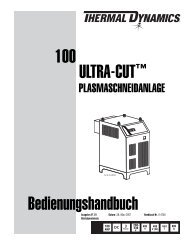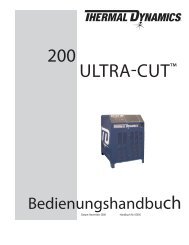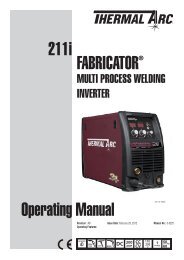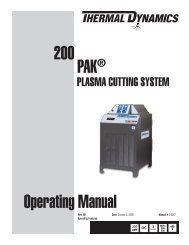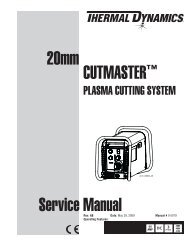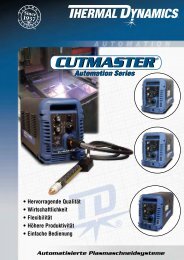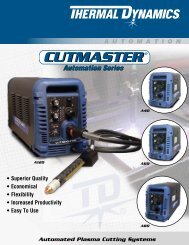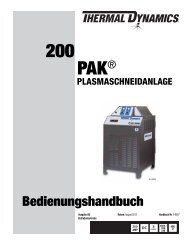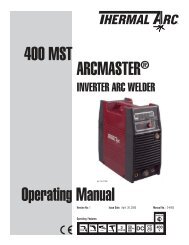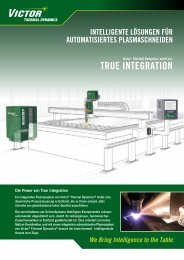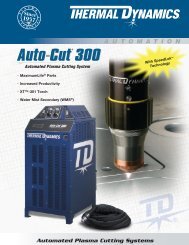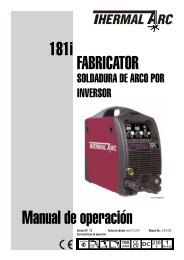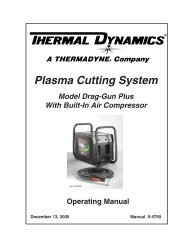CutMaster True Service Manual - Victor Technologies - Europe
CutMaster True Service Manual - Victor Technologies - Europe
CutMaster True Service Manual - Victor Technologies - Europe
Create successful ePaper yourself
Turn your PDF publications into a flip-book with our unique Google optimized e-Paper software.
CUTMASTER 35mm<br />
4T.02 Cut Quality<br />
NOTES<br />
Cut quality depends heavily on setup and<br />
parameters such as torch standoff, alignment with<br />
the workpiece, cutting speed, gas pressures, and<br />
operator ability.<br />
Cut quality requirements differ depending on<br />
application. For instance, nitride build - up and<br />
bevel angle may be major factors when the surface<br />
will be welded after cutting. Dross - free cutting<br />
is important when finish cut quality is desired<br />
to avoid a secondary cleaning operation. The<br />
following cut quality characteristics are illustrated<br />
in the following figure:<br />
Top<br />
Spatter<br />
Cut Surface<br />
Dross<br />
Build-Up<br />
Kerf Width<br />
Cut Surface<br />
Drag Lines<br />
Cut Quality Characteristics<br />
Cut Surface<br />
Bevel Angle<br />
Top Edge<br />
Rounding<br />
A-00007<br />
The desired or specified condition (smooth or rough)<br />
of the face of the cut.<br />
Nitride Build - Up<br />
Nitride deposits can be left on the surface of the cut<br />
when nitrogen is present in the plasma gas stream.<br />
These buildups may create difficulties if the material<br />
is to be welded after the cutting process.<br />
Bevel Angle<br />
The angle between the surface of the cut edge and<br />
a plane perpendicular to the surface of the plate.<br />
A perfectly perpendicular cut would result in a 0°<br />
bevel angle.<br />
Top - Edge Rounding<br />
Rounding on the top edge of a cut due to wearing<br />
from the initial contact of the plasma arc on the<br />
workpiece.<br />
Bottom Dross Buildup<br />
Molten material which is not blown out of the cut<br />
area and resolidifies on the plate. Excessive dross<br />
may require secondary cleanup operations after<br />
cutting.<br />
Kerf Width<br />
The width of the cut (or the width of material removed<br />
during the cut).<br />
Top Spatter (Dross)<br />
Top spatter or dross on the top of the cut caused by<br />
slow travel speed, excess cutting height, or cutting<br />
tip whose orifice has become elongated.<br />
4T.03 General Cutting Information<br />
Piloting<br />
! WARNINGS<br />
Disconnect primary power at the source before<br />
disassembling the power supply, torch, or torch<br />
leads.<br />
Frequently review the Important Safety Precautions<br />
at the front of this manual. Be sure<br />
the operator is equipped with proper gloves,<br />
clothing, eye and ear protection. Make sure<br />
no part of the operator’s body comes into<br />
contact with the workpiece while the torch<br />
is activated.<br />
CAUTION<br />
Sparks from the cutting process can cause damage<br />
to coated, painted, and other surfaces such as glass,<br />
plastic and metal.<br />
NOTE<br />
Handle torch leads with care and protect them<br />
from damage.<br />
Piloting is harder on parts life than actual cutting<br />
because the pilot arc is directed from the electrode<br />
to the tip rather than to a workpiece. Whenever<br />
possible, avoid excessive pilot arc time to improve<br />
parts life.<br />
OPERATION 4T-2 <strong>Manual</strong> 0-5083



